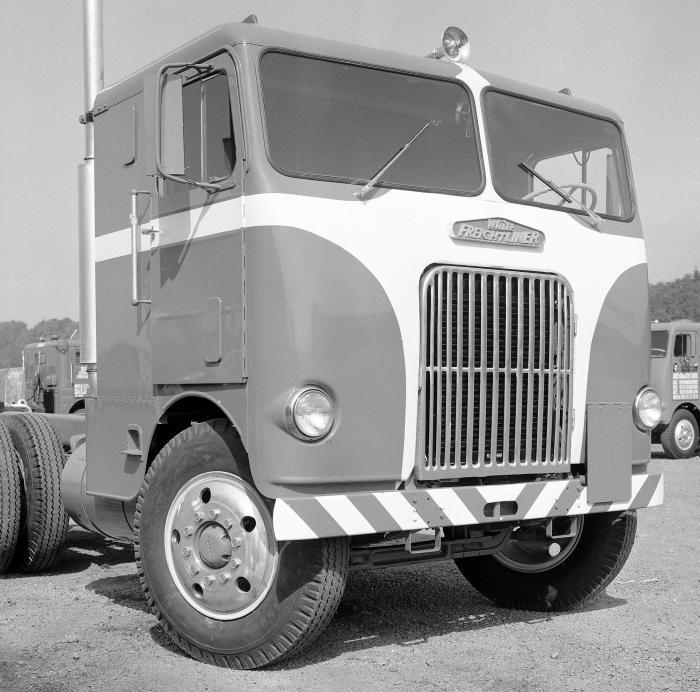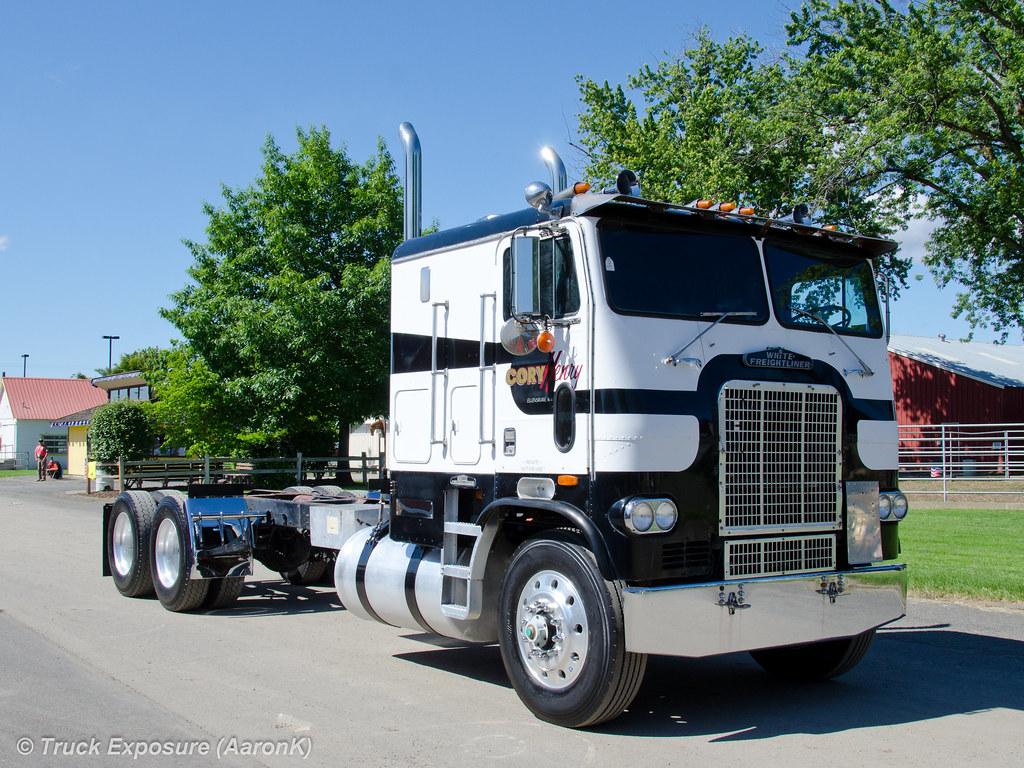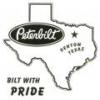-
Posts
113 -
Joined
-
Last visited
Content Type
Profiles
Forums
Events
Gallery
Posts posted by stenfalk
-
-
Hi guys, can someone give me the information for the width and height of the cabin of a Pete 352 and a 362? I am thankful for every hint!
-
Just stunning!
-
A truck with character! I like it very much. ?
The matt black pipes, sun visor and nameplate above the radiator grille make the vehicle individual and harmonize perfectly with the red and chrome parts. Very tastefull!
It is an interesting fact that one of the rarest step variants in reality (only 1972 to 1973 and also not in all units produced during this time) can be seen in the end on almost every model of this great truck.
-
A nice truck with a very nice color pattern. Really well done!
-
Many years ago when I was a child yet, I saw a DAF 3300 in my hometown. It was painted metallic brown with gold trim. It was so impressive that I could never forget this truck again. That will probably happen to me with your model too. Great painting!
-
This is no more model building! That deserves a new word on its own, something like superclasshighendmodelbuilding.
-
A feast for the eyes! Beautiful Pete.
-
Clearly a case for a "How-to-build-a-top-truck-model" textbook. Beautiful!
-
Very detailed! Looks like a real one, great!
-
Here unusual life experiences and unusual model building skills meet! What else should emerge than an unusual model? Fantastic Work!
-
On 8/20/2020 at 6:00 PM, Muncie said:
Good questions,
You caught the obvious detail that I missed. Prior to 1958 The cab did not tilt. Engine access was thru the tunnel in the cab but there were several custom variations..
You're right , I am misidentifying what I've been calling the the 21 series. I'm learning also - I did some checking on the internet. I agree with you and the red and white truck with the solid plate below the grille in the first picture is a 61 series - prior to the 61 series raised cab. My good knowledge, what's left, starts mid 1970's. and is for the 61 series raised cab, and 71 series. I try not to talk about things that I don't know but I also make mistakes - not many (I hope) but it happens. I should have picked up a few pieces of the old documentation for reference long ago when I had the opportunity, but who knew.
The Powerliner was it's own animal. The outside cab dimensions were the same as the wider 71 Series. Detroit Diesel, Cummins and Caterpillar came up with with some big power engines in the 1970's. Way beyond the normal 250 to 300 for the time. At first, Powerliner was minimum 400 horsepower but later became minimum 600 HP. A huge 1200 square inch radiator to cool all that horsepower was behind that big grille. They were expensive trucks. Mostly an owner-operator truck but there were a couple of small fleets that had them.. Very few were built and each one took a lot of custom engineering work. The front of the chassis was unique. As you can see in the photos, Powerliner owners loved their trucks and all of them were well taken care of.
Looking at the photos I found one more thing. The licenses plate bracket on the cab is hinged so that it doesn't interfere with the steering gear. The pitman arm goes thru a notch in the cab in a hard left turn. The license plate bracket could be ordered in several sizes - one to match could be added on the passenger side, also hinged - and one below the bumper could be ordered in various sizes, also hinged. what fun that was
Hello again,
It was a lot of fun working with you to expand my knowledge. You were practically the key to my Freightliner closure, thank you again for that! Your reference to the license plate brackets is valuable also. I am now working on my table and will present it to you as soon as I am ready. But I've already found something interesting: The Turboliner! Also a "strong" piece ... ☺️
Almost forgotten: do you know the usual cabin lengths of the 61 and 71 series? So far for the 61 I've been able to determine 48 ", 58", 65 ", 72" and 75" since the beginning and then 51", 63", 86", 104" and 96" in the flow of time. Then i read about a 56" cab from which the first conventional WFC cabin is said to have been cut. It remains a mystery to me that because I have not found any information about the introduction of the 56". Could that be a typo?
-
Sharp photos of a superbly painted COE. Great job!
-
On 8/18/2020 at 9:15 PM, Muncie said:
No worries, I'm glad that you are interested. Your questions were intelligent questions, very specific and the (very helpful) photos would have taken me much longer to find - that all made it much easier to respond. It was a pleasure to go back thru some memories.
There are a lot of people here willing to provide information, don't be afraid to ask.
Steve, thank you again, I know to appreciate these advantages in the forum.
But I would like to come back to our previous research results. Based to your hints, I have been able to read with many new search terms in other, previously hidden posts. There it could be seen that the Cab series 61 was the variant of the first tilting driver's cab, while the series 21 was the fixed form accessible from the front as in these photo:

Then the construction with the one-piece closed plate under the grill would already be a 61, the perforated plate an indication of the raised 61 and the later wider grill the hallmark of the 71 series. Can you confirm these new information or are you sure that your classification of my original photos is correct?
I also found out that there was a "Powerliner" with a huge grill on the (modified) raised 61 cabin for a few years from 1973, also an interesting sight!


I also found out that there was a "Powerliner" with a huge grill on the Raised 61 cabin for a few years from 1973, also an interesting sight!
Kind regards
Torsten
-
2 hours ago, Muncie said:
Hi Torsten,
your questions
Two another questions are following - is cabin 61 simply a little higher compared to 21 due to an extension at the lower edge? And is the radiator inlet of the various series 21/61/71 different in heights and widths? And if so, do you know the measurements?
I would have to say that I don't know. The 21 series was before my time but I believe it was considerably different from the 61 series. The 21 series is probably smaller than the 61 series. I think Freightliner had the same goal in mind - more horsepower, more cooling and took the opportunity to do a major redesign. Drivers were probably also looking for more room and comfort.
If my memory is correct, the 61 series raised cab has a three inch taller grille opening than the earlier 61 Series (not raised). The 71 Series is four inches wider that the 61 Series - right down the middle - grille, windshield, dash, tunnel, roof, back wall... driver space was the same in both 61 series and the 71 series.
So we've quickly covered COE models. 21 Series, 61 Series, 61 Series Raised cab, and the 71 series also known as Stretch
Other things that you will notice -
The location of the door handle changed at some point in time - from the center of the door to the lower corner - easier to reach.
Grab handle lengths- longer grabhandles were an option on the 61 Series, 61 series Raised Cab, and 71 Series. but became standard late 1970's (?)
Round corner doors - Rounded on the rear lower corner were an option that became standard - also sometime in the late 1970's (might have been early 1980's).
Speaking of doors, the gray truck in the last picture has the "new door." which was a bulkhead design and both front a rear lower corners were rounded. The new door went into production in the early 1980's and is the same door that was used on the FLA and FLB COE's.
The AMT kit has the optional noseskin reinforcement. This is a steel panel that is riveted over the noseskin above the grille. Consolidated Freightways and otherwise very rare. That is why the front of the AMT kit looks different from most photos that you will see. I've seen some model builders convert the AMT kit to the standard noseskin - lot of work.
COE cab sizes: for 71 series, bumper to back of cab, nominal, not exact and varied with bumper options - non-sleeper 48", 51", 63" (AMT single drive), - sleeper 72" (bunk was usable only for storage), 75", 86" (AMT dual drive), 96" and 104"
The Sales Date Book was huge. Freightliner was known as a Custom truck builder. There were some common specs but you will see a lot of different things. Trucks will be modified as they go thru new owners.
Hope this helps,
Steve,
I am touched that you have taken so much time for my requests. I'm afraid that I will unfortunately never be able to repay you for this, not even with information. You will always know more than I do, because you are lucky enough to have grown up with these great machines. I am all the more grateful for your willingness to share this knowledge with me! That's very friendly.
-
Quote
Posted 16 hours ago, Muncie said
thanks for the pics - I couldn't get thru this without them.
Hope this works, Let's see how far we get...
Thank you both very much for the extensive information about the Freightliner COE. I would certainly never have found out that without your help! Steve, you have drawn my eyes to details that can only be discovered with your incredible knowledge. Special thanks therefore! I think I have to create a table now ... ?
Two another questions are following - is cabin 61 simply a little higher compared to 21 due to an extension at the lower edge? And is the radiator inlet of the various series 21/61/71 different in heights and widths? And if so, do you know the measurements?
-
On 8/13/2020 at 1:32 AM, Muncie said:
The Wrecker looks great - good work combining the Freightliner with the wrecker body.
Please post some pictures of the steps that you've seen - I can add some notes and history
On 8/13/2020 at 3:31 AM, leafsprings said:This would be a great topic in the Reference Photo thread. Fender design and steps started to get unpredictable on WF's in the early to mid 70's
Done! Thanks for your support!
-
Quote
Muncie
MCM Ohana
On 8/2/2020 at 9:39 PM, stenfalk said:The Freightliner COE is a good piece of truck. And the model knows how to please, indeed!
Since I am currently looking through many photos to understand the development of the WFT cabin over the years, I have a question. Is the into the casing worked step over the round wheel arch photographically documented? So far I could only identify a variant of two metal brackets or a "ladder" behind the wheel arch without a further step under the door, but I would like to know if there were other shapes.
The Wrecker looks great - good work combining the Freightliner with the wrecker body.
Please post some pictures of the steps that you've seen - I can add some notes and history
leafsprings
MCM Ohana
On 8/2/2020 at 9:39 PM, stenfalk said:Since I am currently looking through many photos to understand the development of the WFT cabin over the years, I have a question. Is the into the casing worked step over the round wheel arch photographically documented?
This would be a great topic in the Reference Photo thread. Fender design and steps started to get unpredictable on WF's in the early to mid 70's
Ok guys, I'll try to add photos to my question. First we see three vehicles with a round wheel cutout. Wire bracket step in the wheel recess.



The next three photos show flattened wheel arches, the entrance step is above the wheel arch.



I couldn't find a photo anywhere that shows a round wheel arch with a "cut out" step like this in
Could this possibly be a "do-it-yourself"? Do you know more?
-
I think this will be a very nice custom build. Which wheelbase did you choose for your model?
-
Definitely one of the most compelling truck models I've ever seen. It is almost impossible to recognize that it is a model and not a real truck. Very very impressive!
-
14 hours ago, Vietnam Vet67 said:
Wow, a lot to read! This is definitely a great tip, thank you for that!
-
I mean valuable information like this:
Quotemackinac359
MCM Ohana
Members
2,441 posts
Location:Upper Peninsula
Full Name:Tim Ahlborn
The official year was '70. Unilite 352 was built through 1969 - but that doesn't mean that some '70 titled units weren't built in '69.
Change the headlamp buckets for the external lip and rivets: '71+
Move the sleeper vents rearward: '70+
Remove the sleeper window indents: '70+ (short lived rear panel). Actual windows were larger.
Larger front nameplate: '73 and newer
Rounded top battery box with 2 air tanks under it: '75+
Larger grab handles: '75+
"Easy Entry" (backwards S) grab handle: '75 newer (first seen in '74 ads with original concept in '73 - I'm seen hanging on the truck with the "Easy Entry" steps in the attached photo)
Lower door handles: '76+
Interior changes: Base interior with Classic padding identical to kit - available through all years.
A third defroster vent was added in '73. Curved rather than flat.
Classic II interior in '75 (think Revell of Germany 359 interior).
Cab sizes: 54, 63, 76, 86, 110 (110" debut late '71 for '72).
Pretty much anything was available exhaust and air cleaner configuration wise.

Tim
-
Incredibly detailed! An overall very lovingly designed truck model. Fun to look at.
-
This is excellent reference material for me and the scratch building of my own superliner in 1/72. Great model building! And very vivid photos!
-
Is there really no one who can help me? I am also happy about any other help, drawings or blueprints of other trucks or information as to whether different vehicle components from one manufacturer can also be used for other brands, like Mack has done wwith cabs for Brockway par exemple. For me, every hint is helpful, really everyone! So, thank you very much for your support.












Dodge LS1000
in WIP: Model Trucks: Big Rigs and Heavy Equipment
Posted
With its large headlights, the Dodge always has a very friendly face. Nevertheless, it remains a nice cabover. And with your model you have set him an extremely handsome monument. Good work!